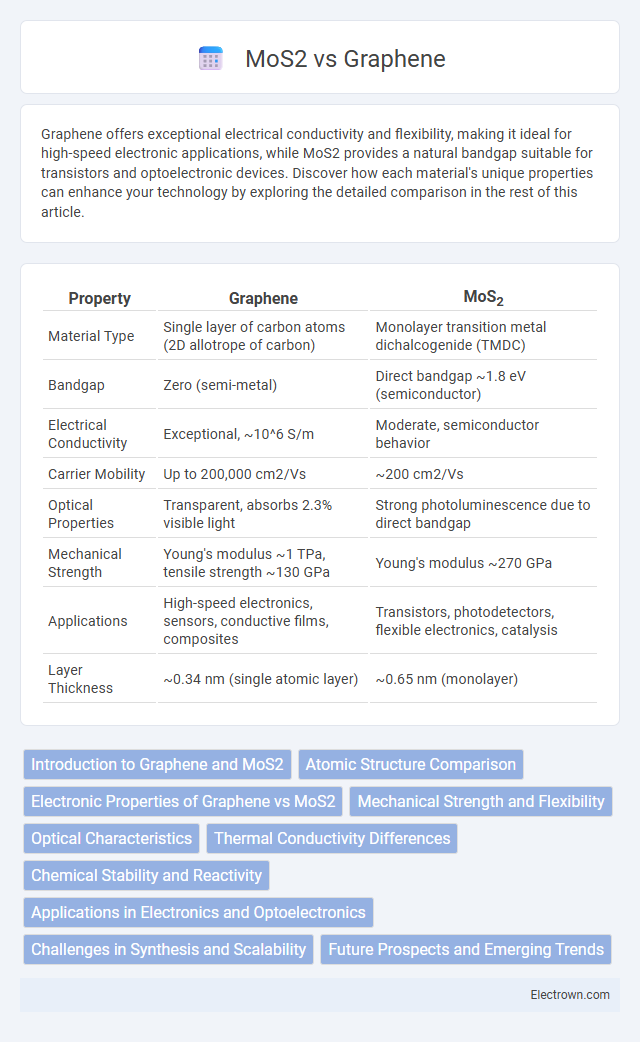Graphene offers exceptional electrical conductivity and flexibility, making it ideal for high-speed electronic applications, while MoS2 provides a natural bandgap suitable for transistors and optoelectronic devices. Discover how each material's unique properties can enhance your technology by exploring the detailed comparison in the rest of this article.
Table of Comparison
| Property | Graphene | MoS2 |
|---|---|---|
| Material Type | Single layer of carbon atoms (2D allotrope of carbon) | Monolayer transition metal dichalcogenide (TMDC) |
| Bandgap | Zero (semi-metal) | Direct bandgap ~1.8 eV (semiconductor) |
| Electrical Conductivity | Exceptional, ~10^6 S/m | Moderate, semiconductor behavior |
| Carrier Mobility | Up to 200,000 cm2/Vs | ~200 cm2/Vs |
| Optical Properties | Transparent, absorbs 2.3% visible light | Strong photoluminescence due to direct bandgap |
| Mechanical Strength | Young's modulus ~1 TPa, tensile strength ~130 GPa | Young's modulus ~270 GPa |
| Applications | High-speed electronics, sensors, conductive films, composites | Transistors, photodetectors, flexible electronics, catalysis |
| Layer Thickness | ~0.34 nm (single atomic layer) | ~0.65 nm (monolayer) |
Introduction to Graphene and MoS2
Graphene, a single layer of carbon atoms arranged in a hexagonal lattice, exhibits exceptional electrical conductivity, mechanical strength, and thermal properties. Molybdenum disulfide (MoS2), a transition metal dichalcogenide, features a layered structure with a direct bandgap, making it suitable for semiconductor applications. Both materials are promising for next-generation electronics, with graphene excelling in conductivity and MoS2 offering tunable electronic and optical properties.
Atomic Structure Comparison
Graphene consists of a single layer of carbon atoms arranged in a two-dimensional hexagonal lattice, exhibiting exceptional electrical conductivity and mechanical strength. In contrast, MoS2 (molybdenum disulfide) features a layered structure with molybdenum atoms sandwiched between two layers of sulfur atoms, forming a trigonal prismatic coordination that imparts a direct bandgap in its monolayer form. The distinct atomic arrangements create divergent electronic properties, where graphene acts as a zero-bandgap semiconductor and MoS2 serves as a semiconductor with a sizable bandgap suitable for transistor applications.
Electronic Properties of Graphene vs MoS2
Graphene exhibits exceptional electronic properties with its zero bandgap and ultra-high electron mobility exceeding 200,000 cm2/V*s, making it ideal for high-speed electronic applications. In contrast, MoS2 possesses a direct bandgap of about 1.8 eV in monolayer form, enabling efficient semiconductor behavior suitable for transistors and optoelectronic devices. Your choice between graphene and MoS2 will depend on whether you prioritize conductivity and speed or semiconducting properties for device integration.
Mechanical Strength and Flexibility
Graphene exhibits exceptional mechanical strength, with a tensile strength of approximately 130 GPa and a Young's modulus around 1 TPa, making it one of the strongest materials known. MoS2, while significantly less strong than graphene, offers superior flexibility and can undergo larger strain without breaking, making it highly suitable for flexible electronics and wearable devices. The intrinsic atomic structure of MoS2 allows it to withstand bending and stretching better than the brittle graphene sheets, despite graphene's unmatched stiffness and strength.
Optical Characteristics
Graphene exhibits exceptional optical transparency, absorbing only about 2.3% of visible light, making it ideal for transparent conductive applications. MoS2, a transition metal dichalcogenide, offers a direct bandgap of approximately 1.8 eV in monolayer form, resulting in strong photoluminescence and enhanced light-matter interaction. These distinct optical characteristics position graphene as a superior choice for transparent electronics, while MoS2 excels in optoelectronic devices such as photodetectors and light-emitting diodes.
Thermal Conductivity Differences
Graphene exhibits exceptionally high thermal conductivity, often exceeding 2000 W/mK, making it one of the best heat conductors known. In contrast, MoS2 has a significantly lower thermal conductivity, typically around 35-50 W/mK, due to its layered structure and phonon scattering effects. Understanding these thermal conductivity differences is crucial for optimizing your materials choice in electronics and thermal management applications.
Chemical Stability and Reactivity
Graphene exhibits exceptional chemical stability due to its strong carbon-carbon bonds and inert surface, making it highly resistant to oxidation and chemical degradation. In contrast, MoS2 has moderate chemical stability but shows higher reactivity, especially at its edges and defect sites, which can be advantageous for catalytic applications. Your choice between graphene and MoS2 should consider these differences in stability and reactivity based on the intended chemical environment and functionality.
Applications in Electronics and Optoelectronics
Graphene's exceptional electrical conductivity and flexibility make it ideal for high-speed transistors, flexible displays, and transparent conductive films in electronics. MoS2 offers a direct bandgap of approximately 1.8 eV, enabling efficient light emission and detection, which suits photodetectors, LEDs, and solar cells in optoelectronics. Combining graphene's conductivity with MoS2's semiconducting properties enhances hybrid devices, improving performance in flexible and wearable electronic applications.
Challenges in Synthesis and Scalability
Graphene synthesis faces challenges in achieving uniform large-area monolayers due to defects and grain boundaries arising from chemical vapor deposition (CVD) processes. In contrast, MoS2 synthesis struggles with controlling thickness and phase purity during exfoliation and CVD methods, impacting electronic properties. Scalability issues for both materials include maintaining consistent quality and defect control essential for industrial applications in flexible electronics and optoelectronics.
Future Prospects and Emerging Trends
Graphene's exceptional electrical conductivity and flexibility position it at the forefront of next-generation electronics and energy storage solutions, while MoS2's inherent semiconducting properties drive advancements in photodetectors and transistors. Emerging trends highlight the integration of graphene and MoS2 in heterostructures, optimizing device performance through synergistic effects. Your future applications will benefit from innovations in scalable synthesis and functionalization techniques, enhancing the practical deployment of these two-dimensional materials.
Graphene vs MoS2 Infographic

 electrown.com
electrown.com